Physicochemical Parameters of Water and Its Implications on Avifauna and Habitat Quality
Abstract
:1. Introduction
2. Materials and Methods
Study Area
3. Methodology
3.1. Site Selection
3.2. Land Use and Land Cover (LULC)
3.3. Water Quality Analysis
3.4. Waterbird Survey
3.5. Data Analysis
4. Results and Discussion
4.1. pH and Electrical Conductivity
4.2. Biological Oxygen Demand (BOD) and Dissolved Oxygen (DO)
4.3. Total Dissolved Solids (TDSs) and Salinity
4.4. Waterbird Population
5. Conclusions
Author Contributions
Funding
Institutional Review Board Statement
Informed Consent Statement
Data Availability Statement
Acknowledgments
Conflicts of Interest
References
- Fraser, L.H.; Keddy, P.A. (Eds.) The World’s Largest Wetlands: Ecology and Conservation; Cambridge University Press: Cambridge, UK, 2005. [Google Scholar] [CrossRef]
- Keddy, P.A.; Fraser, L.H.; Solomeshch, A.I.; Junk, W.J.; Campbell, D.R.; Arroyo, M.T.; Alho, C.J. Wet and wonderful: The world’s largest wetlands are conservation priorities. BioScience 2009, 59, 39–51. [Google Scholar] [CrossRef] [Green Version]
- Davidson, N.C.; Finlayson, C.M. Extent, regional distribution and changes in area of different classes of wetland. Mar. Freshw. Res. 2018, 69, 1525–1533. [Google Scholar] [CrossRef] [Green Version]
- MA Condition Working Group. Appendix D—Glossary. In Current State & Trends Assessment; The Millennium Ecosystem Assessment: Washington, DC, USA, 2005. [Google Scholar]
- Gardner, R.C.; Davidson, N.C. The Ramsar convention. In Wetlands; Springer: Berlin/Heidelberg, Germany, 2011; pp. 189–203. [Google Scholar]
- Gaget, E.; Le Viol, I.; Pavón-Jordán, D.; Cazalis, V.; Kerbiriou, C.; Jiguet, F.; Popoff, N.; Dami, L.; Mondain-Monval, J.; du Rau, P.D.; et al. Assessing the effectiveness of the Ramsar Convention in preserving wintering waterbirds in the Mediterranean. Biol. Conserv. 2020, 243, 108485. [Google Scholar] [CrossRef]
- Weise, K.; Paganini, M.; Wolf, B.; Fitoka, E.; Hansen, H.; Bonino, E.; van Valkengoed, E. GlobWetland II-The new Opportunities with Sentinel-2 for Wetland Mapping and Monitoring. In Proceedings of the First Sentinel-2 Preparatory Symposium, Frascati, Italy, 23–27 April 2012; Volume 707, p. 5. [Google Scholar]
- Dabrowska-Zielinska, K.; Bartold MGurdak, R. POLWET—System for new space-based products for wetlands under RAMSAR Convention. Geoinf. Issues 2016, 8, 25–35. [Google Scholar] [CrossRef]
- Fretwell, J.D. National Water Summary on Wetland Resources; US Government Printing Office: Washington, DC, USA, 1996; Volume 2425. [Google Scholar]
- Lougheed, V.L.; Crosbie, B.; Chow-Fraser, P. Predictions on the effect of common carp (Cyprinus carpio) exclusion on water quality, zooplankton, and submergent macrophytes in a Great Lakes wetland. Can. J. Fish. Aquat. Sci. 1998, 55, 1189–1197. [Google Scholar] [CrossRef]
- Riens, J.R.; Schwarz, M.S.; Mustafa, F.; Hoback, W.W. Aquatic Macroinvertebrate Communities and Water Quality at Buffered and Non-Buffered Wetland Sites on Federal Waterfowl Production Areas in the Rainwater Basin, Nebraska. Wetlands 2013, 33, 1025–1036. [Google Scholar] [CrossRef]
- Wang, W.; Fraser, J.D.; Chen, J. Distribution and Long-Term Population Trends of Wintering Waterbirds in Poyang Lake, China. Wetlands 2019, 39, 125–135. [Google Scholar] [CrossRef]
- Kingsford, R.; Biggs, H.C.; Pollard, S.R. Strategic Adaptive Management in freshwater protected areas and their rivers. Biol. Conserv. 2011, 144, 1194–1203. [Google Scholar] [CrossRef]
- Mishra, A.P.; Khali, H.; Singh, S.; Pande, C.B.; Singh, R.; Chaurasia, S.K. An Assessment of In-situ Water Quality Parameters and its variation with Landsat 8 Level 1 Surface Reflectance datasets. Int. J. Environ. Anal. Chem. 2021, 1–23. [Google Scholar] [CrossRef]
- Begum, A. Harikrishnarai Study on the Quality of Water in Some Streams of Cauvery River. E-J. Chem. 2008, 5, 377–384. [Google Scholar] [CrossRef] [Green Version]
- Wenger, A.S.; Fabricius, K.E.; Jones, G.P.; Brodie, J.E. Sedimentation, eutrophication and pollution: Effects on coral reef fishes. In Ecology of Fishes on Coral Reefs: The Functioning of an Ecosystem in a Changing World; Cambridge University Press: Cambridge, UK, 2015; pp. 145–153. [Google Scholar]
- Dunson, W.A.; Travis, J. The Role of Abiotic Factors in Community Organization. Am. Nat. 1991, 138, 1067–1091. [Google Scholar] [CrossRef]
- Mishra, A.P.; Singh, R. Physico-chemical characteristics of Asan wetland with reference to Avian and Molluscan diversity, Doon Valley (Uttarakhand), India. Int. Res. J. Environ. Sci. 2019, 8, 1–11. [Google Scholar]
- Ogden, J.C.; Baldwin, J.D.; Bass, O.L.; Browder, J.A.; Cook, M.I.; Frederick, P.C.; Frezza, P.E.; Galvez, R.A.; Hodgson, A.B.; Meyer, K.D.; et al. Waterbirds as indicators of ecosystem health in the coastal marine habitats of southern Florida: 1. Selection and justification for a suite of indicator species. Ecol. Indic. 2014, 44, 148–163. [Google Scholar] [CrossRef]
- Chatterjee, A.; Adhikari, S.; Pal, S.; Mukhopadhyay, S.K. Foraging guild structure and niche characteristics of waterbirds wintering in selected sub-Himalayan wetlands of India. Ecol. Indic. 2020, 108, 105693. [Google Scholar] [CrossRef]
- Sun, X.; Shen, J.; Xiao, Y.; Li, S.; Cao, M. Habitat suitability and potential biological corridors for waterbirds in Yancheng coastal wetland of China. Ecol. Indic. 2023, 148, 110090. [Google Scholar] [CrossRef]
- Weber, L.M.; Haig, S.M. Shorebird Use of South Carolina Managed and Natural Coastal Wetlands. J. Wildl. Manag. 1996, 60, 73. [Google Scholar] [CrossRef]
- Ma, Z.; Cai, Y.; Li, B.; Chen, J. Managing Wetland Habitats for Waterbirds: An International Perspective. Wetlands 2010, 30, 15–27. [Google Scholar] [CrossRef]
- Taft, O.W.; Colwell, M.A.; Isola, C.R.; Safran, R.J. Waterbird responses to experimental drawdown: Implications for the multispecies management of wetland mosaics. J. Appl. Ecol. 2002, 39, 987–1001. [Google Scholar] [CrossRef] [Green Version]
- Ramachandra, T.V.; Solanki, M. Ecological assessment of lentic water bodies of Bangalore. Minist. Sci. Technol. 2007, 25, 96. [Google Scholar]
- O’Neal, B.J.; Heske, E.J.; Stafford, J.D. Waterbird Response to Wetlands Restored Through the Conservation Reserve Enhancement Program. J. Wildl. Manag. 2008, 72, 654–664. [Google Scholar] [CrossRef]
- Yadav, A.K.; Dash, P.; Mohanty, A.; Abbassi, R.; Mishra, B.K. Performance assessment of innovative constructed wetland-microbial fuel cell for electricity production and dye removal. Ecol. Eng. 2012, 47, 126–131. [Google Scholar] [CrossRef]
- Galib, S.M.; Lucas, M.C.; Chaki, N.; Fahad, F.H.; Mohsin, A. Is current floodplain management a cause for concern for fish and bird conservation in Bangladesh’s largest wetland? Aquat. Conserv. Mar. Freshw. Ecosyst. 2018, 28, 98–114. [Google Scholar] [CrossRef] [Green Version]
- Asian Waterbird Census, Uttarakhand Biodiversity Board. Report on Uttarakhand Asian Waterbird Census; Uttarakhand Biodiversity Board: Dehradun, India, 2023. [Google Scholar]
- Mohan, D.; Sondhi, S.; Kumar, R.; Singh, P.; Datta, S.B. A Checklist of the Birds of Asan Conservation Reserve; Uttarakhand Forest Department and Titli Trust: Dehradun, India, 2023. [Google Scholar]
- Islam, M.Z.; Rahmani, A.R. Important Bird Areas in India: Priority Sites for Conservation; Indian Bird Conservation Network: Bombay, India; Natural History Society and Birdlife International (UK): London, UK, 2004; p. 1133. [Google Scholar]
- Patra, R.; Bisht, M.; Kumar Sipu, K. Amit., Saevus. 2022, pp. 70–73. Available online: https://www.magzter.com/IN/Saevus-Wildlife-India-LLP/Saevus/Animals-and-Pets/922955 (accessed on 1 May 2023).
- Mohan, D.; Sondhi, S. An Updated Checklist of the Birds of Uttarakhand; Uttarakhand Forest Department: Dehradun, India, 2015. [Google Scholar]
- Kaushik, T.K.; Gupta, R.C. Understanding and Analysing the Coordinates of Diversity of Wetland Birds of Asan Barrage near Paonta Sahib, Northern India. Our Nat. 2013, 11, 192–200. [Google Scholar] [CrossRef] [Green Version]
- Jha, B.R.; Rayamajhi, A.; Dahanukar, N.; Harrison, A.; Pinder, A. Tor putitora. In The IUCN Red List of Threatened Species; IUCN Global Species Programme Red List Unit: Cambridge, UK, 2018; e. T126319882A126322226. [Google Scholar]
- Mishra, A.P.; Rai, I.D.; Pangtey, D.; Padalia, H. Vegetation Characterization at Community Level Using Sentinel-2 Satellite Data and Random Forest Classifier in Western Himalayan Foothills, Uttarakhand. J. Indian Soc. Remote Sens. 2021, 49, 759–771. [Google Scholar] [CrossRef]
- Bassi, N.; Kumar, M.D.; Sharma, A.; Pardha-Saradhi, P. Status of wetlands in India: A review of extent, ecosystem benefits, threats and management strategies. J. Hydrol. Reg. Stud. 2014, 2, 1–19. [Google Scholar] [CrossRef] [Green Version]
- American Public Health Association (APHA). Standard Methods for the Examination of Water and Wastewater, 23rd ed.; APHA: Washington, DC, USA, 2017. [Google Scholar]
- Mishra, A.P.; Singh, S.; Jani, M.; Singh, K.A.; Pande, C.B.; Varade, A.M. Assessment of water quality index using Analytic Hierarchy Process (AHP) and GIS: A case study of a struggling Asan River. Int. J. Environ. Anal. Chem. 2022, 1–13. [Google Scholar] [CrossRef]
- Khadri, S.F.R.; Pande, C. Ground water flow modeling for calibrating steady state using MODFLOW software: A case study of Mahesh River basin, India. Model. Earth Syst. Environ. 2016, 2, 39. [Google Scholar] [CrossRef] [Green Version]
- Gilfedder, B.; Frei, S.; Hofmann, H.; Cartwright, I. Groundwater discharge to wetlands driven by storm and flood events: Quantification using continuous Radon-222 and electrical conductivity measurements and dynamic mass-balance modelling. Geochim. Et Cosmochim. Acta 2015, 165, 161–177. [Google Scholar] [CrossRef]
- Whigham, D.F.; Jordan, T.E. Isolated wetlands and water quality. Wetlands 2003, 23, 541–549. [Google Scholar] [CrossRef]
- Brevik, E.C.; Fenton, T.E.; Horton, R. Effect of Daily Soil Temperature Fluctuations on Soil Electrical Conductivity as Measured with the Geonics®EM-38. Precis. Agric. 2004, 5, 145–152. [Google Scholar] [CrossRef]
- World Health Organization (WHO). Guidelines for Drinking Water Quality, Incorporating 1st and 2nd Addenda, 3rd ed.; Recommendations; WHO: Geneva, Switzerland, 2008; Volume 1. [Google Scholar]
- Ajibade, O.M.; Banjo, O.A.; Oguntuyaki, T.A.; Osobamiro, T.M.; Ajakore, A.A. Implications of carbonates and chlorides contam-ination in groundwater: Examples from textile tie and dye markets in some parts of Southwestern Nigeria. Indian J. Sci. Technol. 2020, 13, 3349–3363. [Google Scholar] [CrossRef]
- Green, A.J.; Alcorlo, P.; Peeters, E.T.; Morris, E.P.; Espinar, J.L.; Bravo-Utrera, M.A.; Bustamante, J.; Díaz-Delgado, R.; Koelmans, A.A.; Mateo, R.; et al. Creating a safe operating space for wetlands in a changing climate. Front. Ecol. Environ. 2017, 15, 99–107. [Google Scholar] [CrossRef] [Green Version]
- Herbert, E.R.; Boon, P.; Burgin, A.J.; Neubauer, S.C.; Franklin, R.B.; Ardón, M.; Hopfensperger, K.N.; Lamers, L.P.M.; Gell, P. A global perspective on wetland salinization: Ecological consequences of a growing threat to freshwater wetlands. Ecosphere 2015, 6, art206. [Google Scholar] [CrossRef]
- Hazra, P.; Sinha, A.; Mondal, P.; Khan, T. Calendar-effects and temperature-impacts in migratory waterbirds at three tropical Indian wetlands. Acta Oecologica 2012, 43, 60–71. [Google Scholar] [CrossRef]
- Yetis, R.; Nergiz, H.; Yetis, A.D. Effects of water quality on the species richness and population distribution of waterbirds in Ahlat marshes, Turkey. Biologia 2021, 76, 3299–3309. [Google Scholar] [CrossRef]
- Thapa, J.B.; Saund, T.B. Water Quality Parameters and Bird Diversity in Jagdishpur Reservoir, Nepal. Nepal J. Sci. Technol. 2012, 13, 143–155. [Google Scholar] [CrossRef] [Green Version]
- Sulai, P.; Nurhidayu, S.; Aziz, N.; Zakaria, M.; Barclay, H.; Azhar, B. Effects of water quality in oil palm production landscapes on tropical waterbirds in Peninsular Malaysia. Ecol. Res. 2015, 30, 941–949. [Google Scholar] [CrossRef]
- Boros, E. Generalized estimation of nutrient loading of waterbirds on inland aquatic ecosystems. Methodsx 2021, 8, 101465. [Google Scholar] [CrossRef]
- Gautam, V.K.; Pande, C.B.; Moharir, K.N.; Varade, A.M.; Rane, N.L.; Egbueri, J.C.; Alshehri, F. Prediction of Sodium Hazard of Irrigation Purpose using Artificial Neural Network Modelling. Sustainability 2023, 15, 7593. [Google Scholar] [CrossRef]
- Liu, X.; Qiu, Y.; Zheng, Z.; Hong, Q.; Zhang, Y.; Qian, Q.; Wan, B.; Chen, Q. Spatiotemporal Changes in Waterfowl Habitat Suitability in the Caohai Lake Wetland and Responses to Human Activities. Sustainability 2022, 14, 14409. [Google Scholar] [CrossRef]
- Dong, Z.; Wang, Z.; Liu, D.; Li, L.; Ren, C.; Tang, X.; Jia, M.; Liu, C. Assessment of habitat suitability for waterbirds in the West Songnen Plain, China, using remote sensing and GIS. Ecol. Eng. 2013, 55, 94–100. [Google Scholar] [CrossRef]
- Na, X.D.; Zang, S.; Zhang, Y.H.; Li, W. Assessing Breeding Habitat Suitability for the Endangered red-Crowned Crane (Grus japonensis) Based on Multi-Source Remote Sensing Data. Wetlands 2015, 35, 955–967. [Google Scholar] [CrossRef]
- Bartold, M.; Kluczek, M. A Machine Learning Approach for Mapping Chlorophyll Fluorescence at Inland Wetlands. Remote Sens. 2023, 15, 2392. [Google Scholar] [CrossRef]
- Kim, Y.W.; Kim, T.; Shin, J.; Lee, D.-S.; Park, Y.-S.; Kim, Y.; Cha, Y. Validity evaluation of a machine-learning model for chlorophyll a retrieval using Sentinel-2 from inland and coastal waters. Ecol. Indic. 2022, 137, 108737. [Google Scholar] [CrossRef]

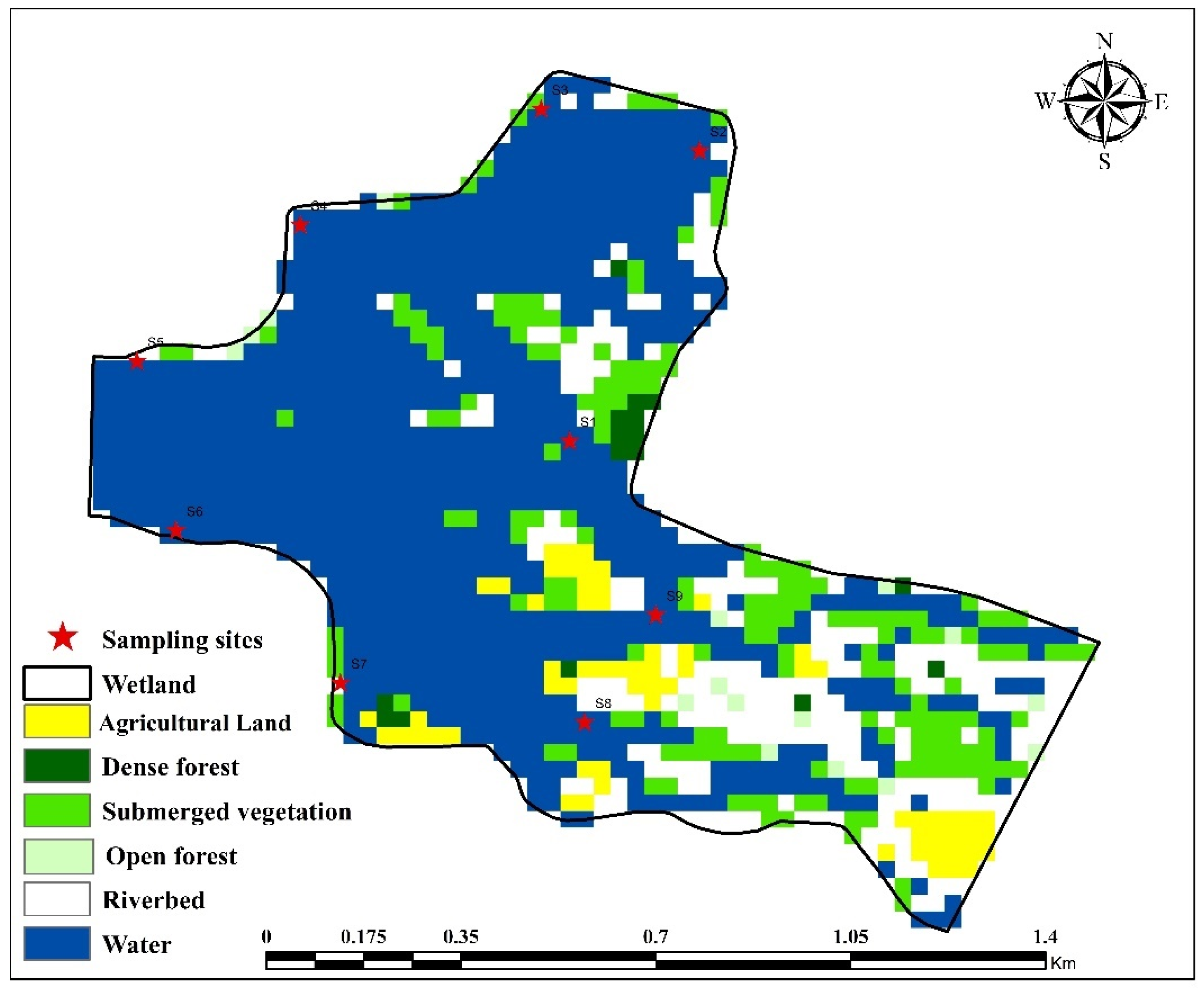

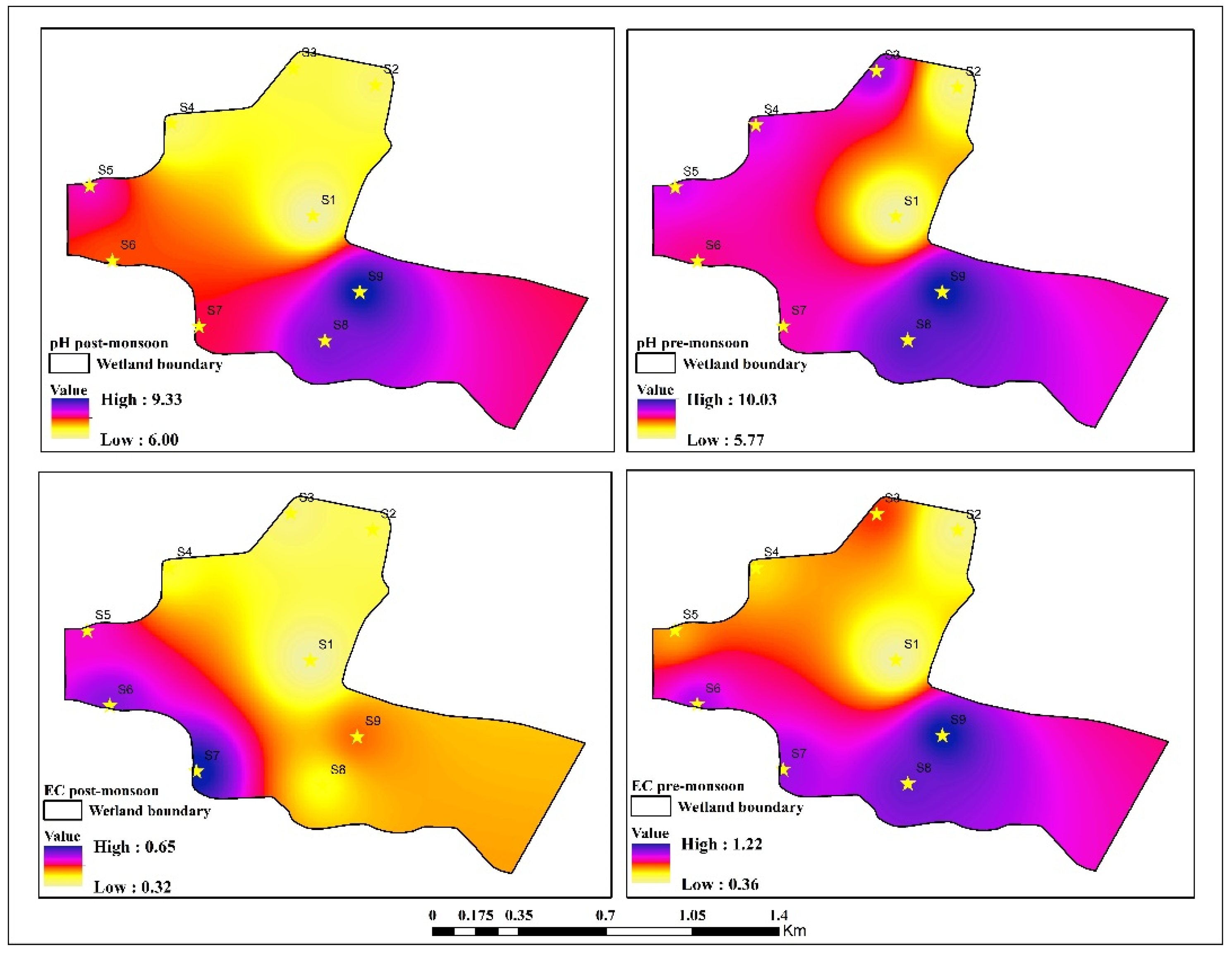
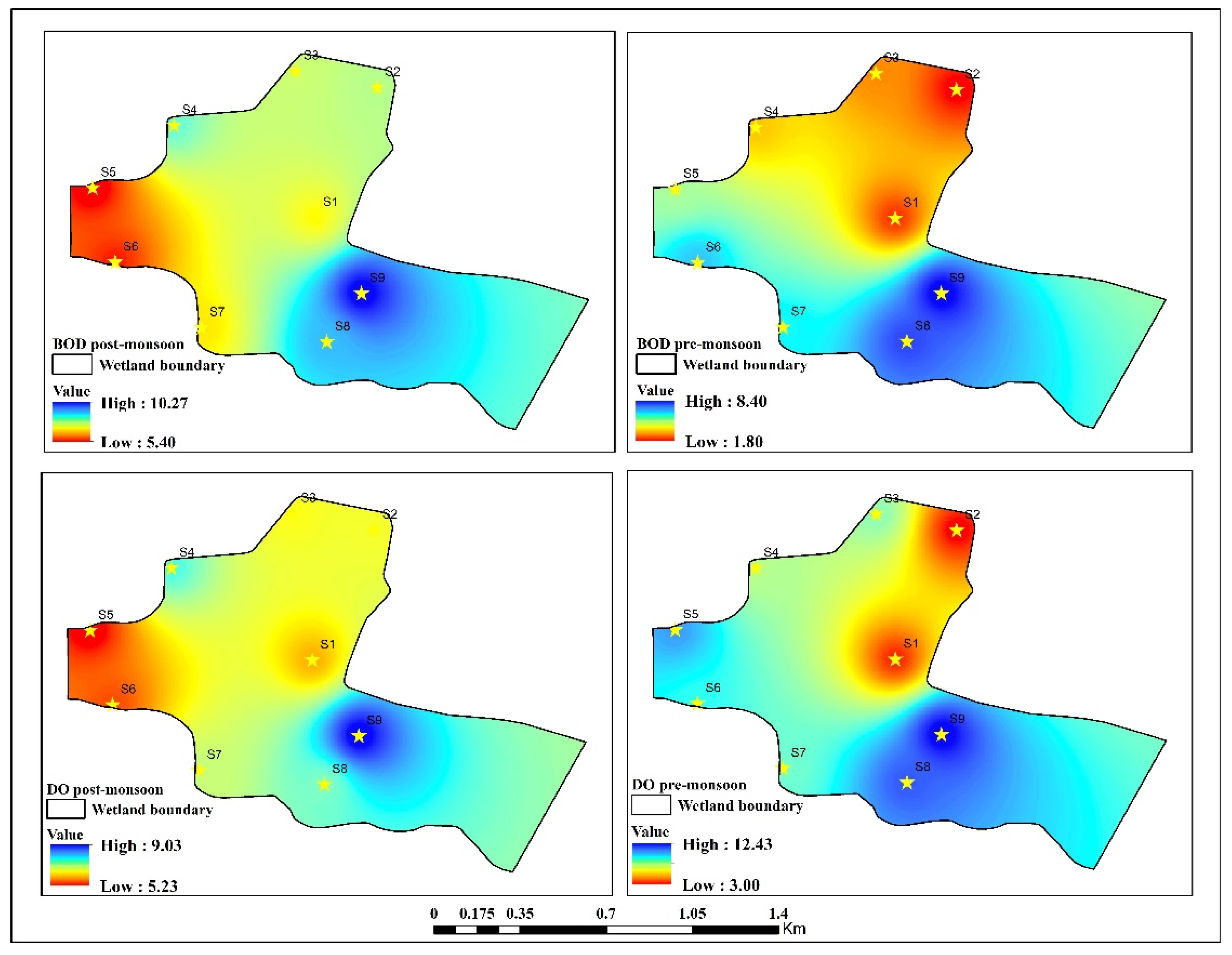
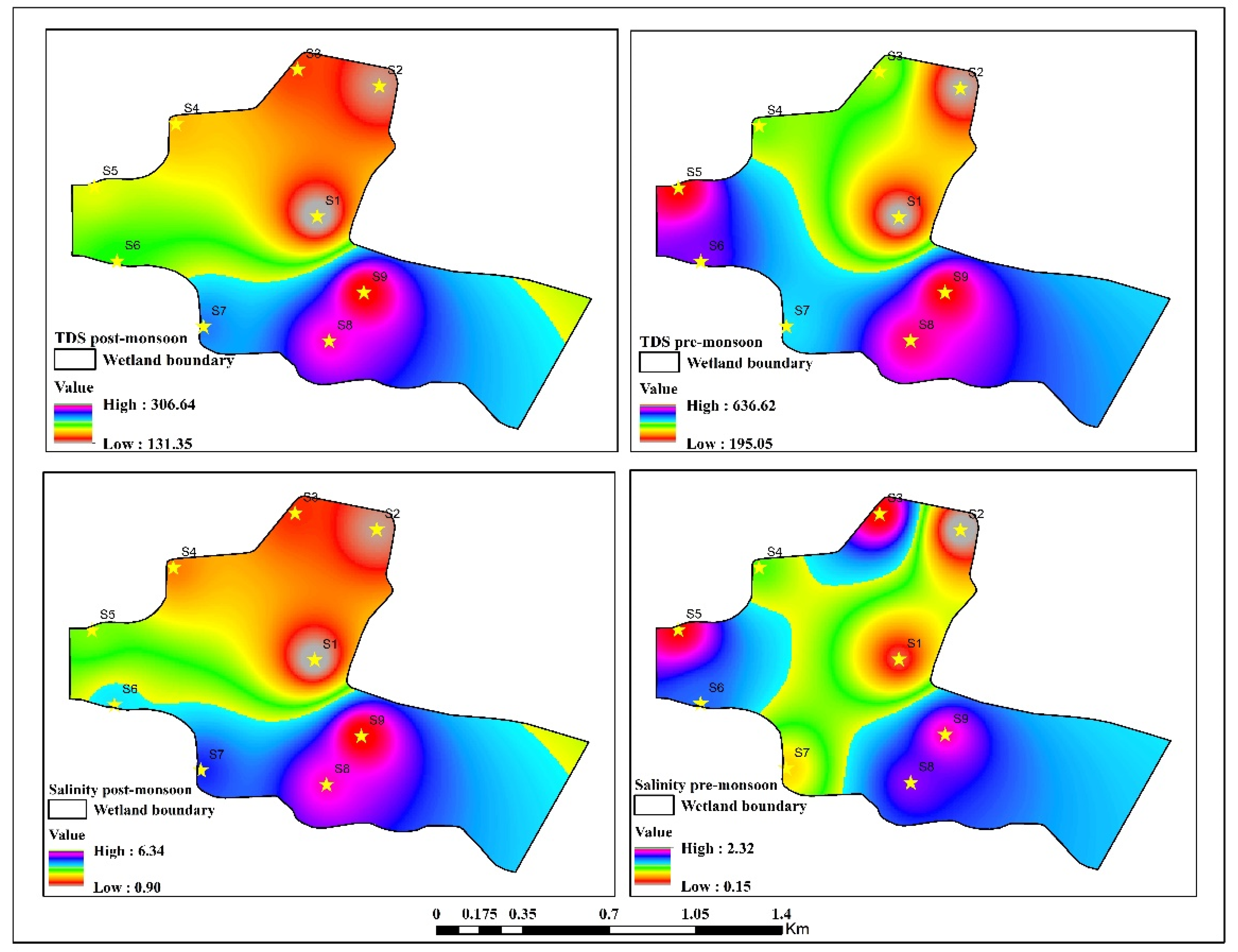

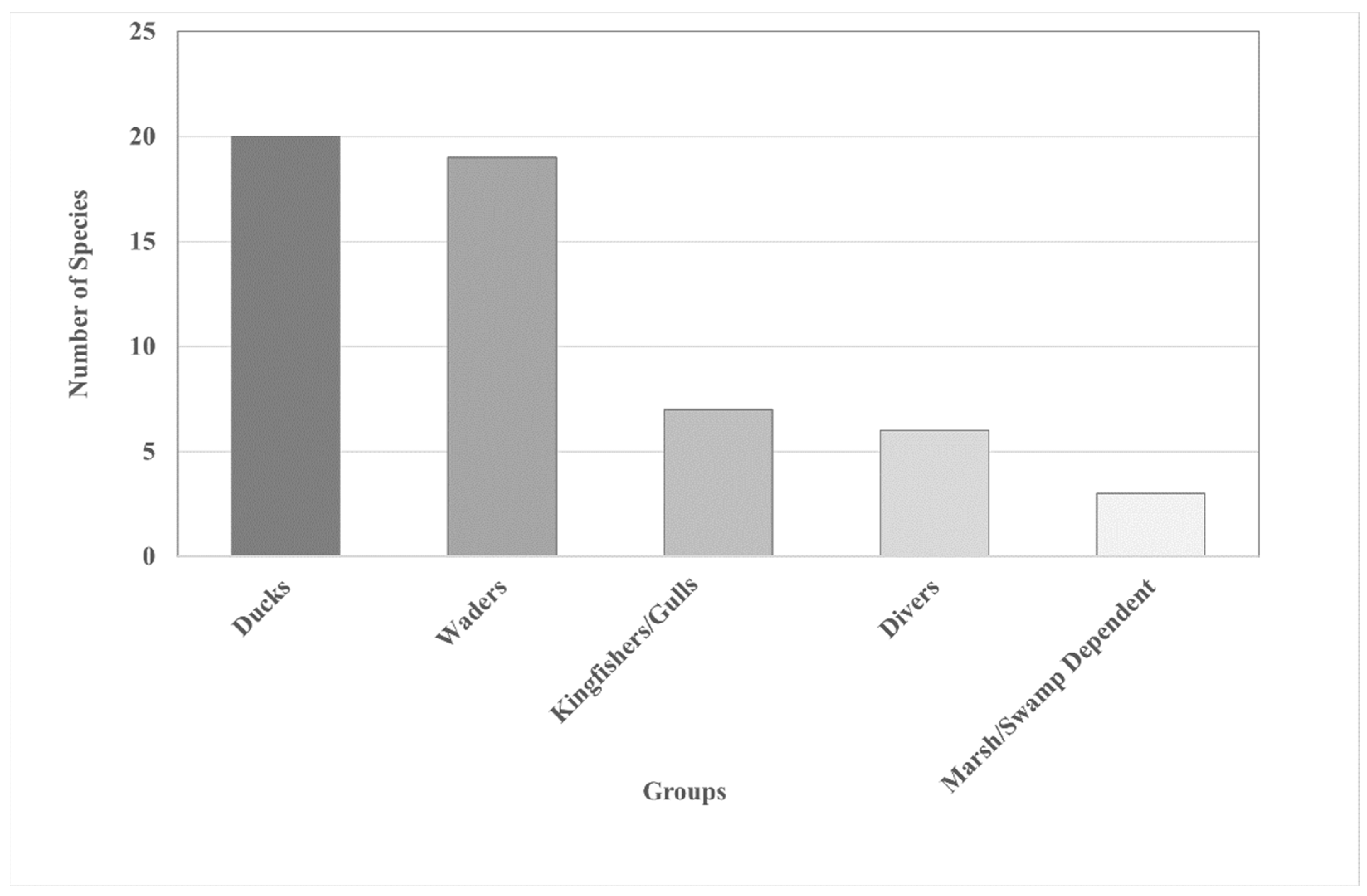


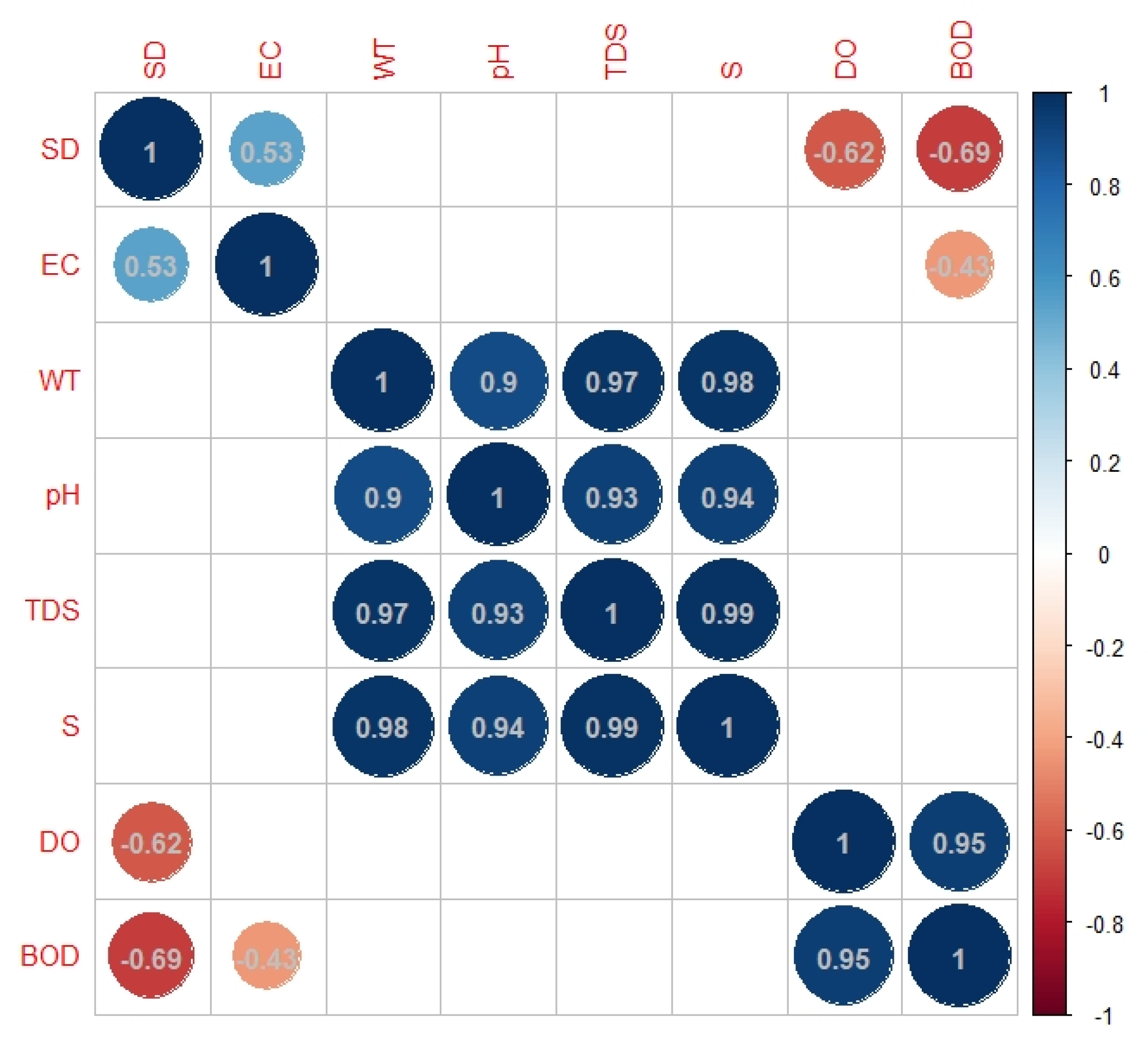
| Site Code | Habitat Characteristics |
|---|---|
| S1 | Swampy area dominated by Typha and reeds |
| S2 | Water body near human settlement |
| S3 | Swampy area near the forest patch |
| S4 | Deep water zone near the forested area |
| S5 | Deep water zone near the barrage |
| S6 | Deep water zone near the barrage |
| S7 | Stagnant water amidst agricultural land |
| S8 | Riverine area |
| S9 | Riverine area |
| Category | Density (per km2) ± SD * | Total Individuals |
|---|---|---|
| 2021(Overall) | 62.32 ± 2.36 | 1957 |
| 2022 (Overall) | 72.86 ± 3.37 | 2288 |
| Pre-Monsoon (2021) | 20.09 ± 0.60 | 631 |
| Pre-Monsoon (2022) | 17.57 ± 0.53 | 552 |
| Post-Monsoon (2021) | 42.22 ± 1.75 | 1326 |
| Post-Monsoon (2022) | 55.28 ± 2.84 | 1736 |
| Pre-Monsoon (2021 and 2022) | 37.67 ± 1.13 | 1183 |
| Post-Monsoon (2021 and 2022) | 97.51 ± 4.60 | 3062 |
| Season | Species Density (per km2) ± SD * | ||||
|---|---|---|---|---|---|
| Divers | Ducks | Waders | Kingfishers/Gulls | Marsh-/Swamp-Dependent | |
| Pre-Monsoon (2021) | 6.15 ± 1.25 | 7.73 ± 0.42 | 5.16 ± 0.3 | 0.44 ± 0.03 | 0.6 ± 0.11 |
| Post-Monsoon (2021) | 11.85 ± 3.51 | 24.33 ± 1.63 | 5.13 ± 0.52 | 0.44 ± 0.02 | 0.48 ± 0.08 |
| Pre-Monsoon (2022) | 5.09 ± 0.99 | 7.29 ± 0.47 | 4.71 ± 0.24 | 0.25 ± 0.00 | 0.54 ± 0.11 |
| Post-Monsoon (2022) | 16.11 ± 5.24 | 33.41 ± 2.93 | 4.81 ± 0.46 | 0.51 ± 0.03 | 0.44 ± 0.09 |
Disclaimer/Publisher’s Note: The statements, opinions and data contained in all publications are solely those of the individual author(s) and contributor(s) and not of MDPI and/or the editor(s). MDPI and/or the editor(s) disclaim responsibility for any injury to people or property resulting from any ideas, methods, instructions or products referred to in the content. |
© 2023 by the authors. Licensee MDPI, Basel, Switzerland. This article is an open access article distributed under the terms and conditions of the Creative Commons Attribution (CC BY) license (https://creativecommons.org/licenses/by/4.0/).
Share and Cite
Mishra, A.P.; Kumar, S.; Patra, R.; Kumar, A.; Sahu, H.; Chandra, N.; Pande, C.B.; Alshehri, F. Physicochemical Parameters of Water and Its Implications on Avifauna and Habitat Quality. Sustainability 2023, 15, 9494. https://doi.org/10.3390/su15129494
Mishra AP, Kumar S, Patra R, Kumar A, Sahu H, Chandra N, Pande CB, Alshehri F. Physicochemical Parameters of Water and Its Implications on Avifauna and Habitat Quality. Sustainability. 2023; 15(12):9494. https://doi.org/10.3390/su15129494
Chicago/Turabian StyleMishra, Arun Pratap, Sipu Kumar, Rounak Patra, Amit Kumar, Himanshu Sahu, Naveen Chandra, Chaitanya B. Pande, and Fahad Alshehri. 2023. "Physicochemical Parameters of Water and Its Implications on Avifauna and Habitat Quality" Sustainability 15, no. 12: 9494. https://doi.org/10.3390/su15129494
APA StyleMishra, A. P., Kumar, S., Patra, R., Kumar, A., Sahu, H., Chandra, N., Pande, C. B., & Alshehri, F. (2023). Physicochemical Parameters of Water and Its Implications on Avifauna and Habitat Quality. Sustainability, 15(12), 9494. https://doi.org/10.3390/su15129494






